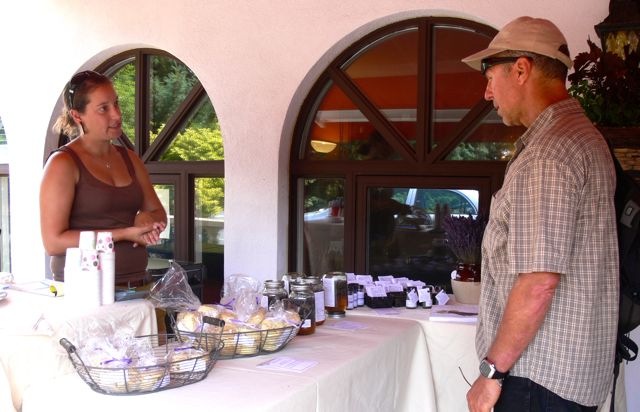Kevin and Abigail of Weir’s Lane
Lavender had invited us on a Farm Crawl they organized with two other
farms. When we pulled up to Kevin’s farm
the rows of lavender in the front field and the stucco, Mediterranean style
house made us wonder if in fact we were in Provence.
Kevin was just starting his beekeeping demonstration when we arrived. Mia kept her distance but I had kept bees in my youth so I got right in there and helped with the demonstration. Not only do the bees pollinate the lavender, but they produce amazingly delicious lavender honey.
Kevin was just starting his beekeeping demonstration when we arrived. Mia kept her distance but I had kept bees in my youth so I got right in there and helped with the demonstration. Not only do the bees pollinate the lavender, but they produce amazingly delicious lavender honey.
After checking out their recent planting and striking established rows, Mia tried her hand at making a lavender wand.
I thought she might cast wonderful lavender spells with it but she mostly uses it to smack me when I annoy her; at least it smells nice when she does. The lavender releases fragrance when the flowers are bruised by rolling it between your hands or whacking your partner with it.
 |
| Abigail and Mia showing off the final lavender wand. |
We toured the farm store, sampled some lavender flavoured food and were struck by the many herbs lavender can be mixed with.
I am going to try and grow all the
herbs for Herbs de Provence in the herb garden next year. I even bought two Royal Velvet lavender
plants to plant in our garden. They are
one of the nicest edible varieties.
 |
| Misha and Kevin checking out the front lavender field |
Our next stop was ManoRun Organic Farm. This rustic mixed farm featured organic vegetables and herbs, horses, cows, chickens and an outdoor brick pizza oven.
We learned something
about the borage that is growing in our yard.
I had no idea you could eat it and use it to flavour water. It’s great for skin health and apparently a
great addition to the compost heap once it is harvested. We love borage!
The last stop was Jerry’s berries where
we filled up on raspberries. The berries
were amazing but I kept trying to switch rows because the berries in the
adjacent rows always seemed a little nicer and more plentiful. Of course once I got to the other row, the
row I had come from looked better.
Suffice it to say, Mia filled her container in half the time I did by
staying in the same row. After a short
jam making demo we were back on the road and headed to the train station.
 |
| The search for the perfect berry; check out the perfect berry picking form. |
On the train ride back we reflected on
our amazing day in the country and felt completely satisfied with our little
taste of Provence as we pulled into the station in Paris.
Misha
Misha





















